
Over the years I have owned and used far more telescopes than cars. This page gives some images of some of them.
The first telescope I used on the sky was an 8 x 50 'elbow' telescope loaned from the Astronomical Society of Western Australia shortly after I joined in 1967. At first I did not have any mounting for the telescope, so I used to rest it on the steps of our folding ladder. After a while I managed to obtain a set of tripod legs and eventually build an equatorial head which meant that I could observe with more freedom. After using this instrument for about 6 months, I purchased a 50mm refractor. The first telescope I owned.
After I had been in the club for about 18 months, one of the members sold me a 6" f/4 mirror, which, over the next 6 months, I managed to turn into a telescope.

In 1971 the same member of the astronomy club offered me his 5" f/5 refractor along with a shed-type, folding roof observatory at a very cheap price, and so this instrument became my 3rd telescope.
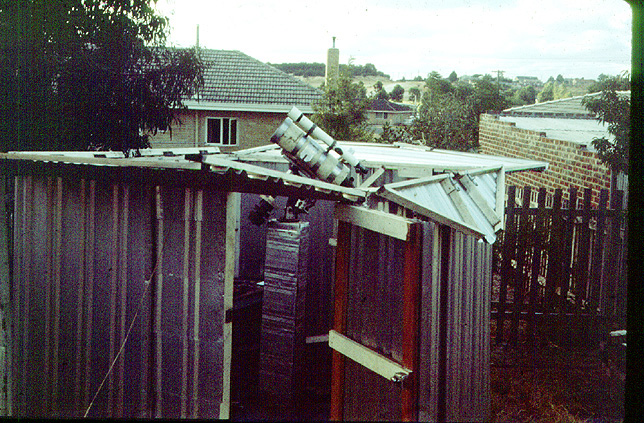
The telescope came with several accessories including a motor drive and a film holder for taking photographs through the telescope using pieces of 120 film. Unfortunately, the motor drive caused too much vibration for photography. However eventually I managed to concoct a method of hand driving the telescope which worked quite well. I also made up a pipe pier that could be bolted to a car wheel rim that allowed me to take the telescope on country trips for dark skies, as shown in the photos below.
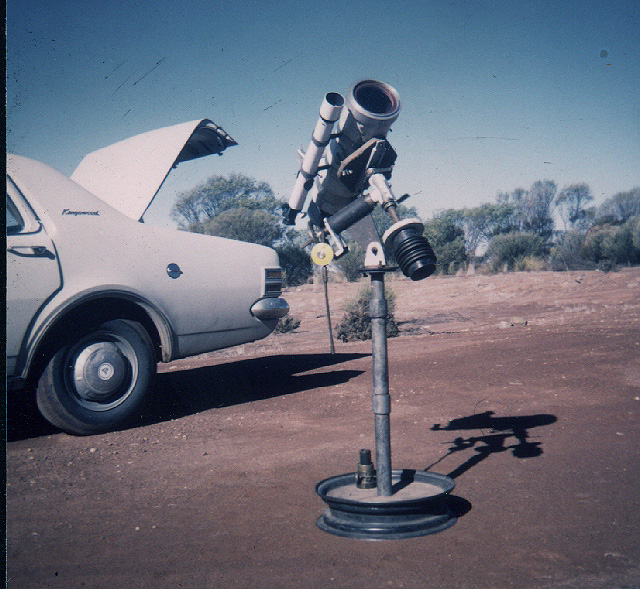
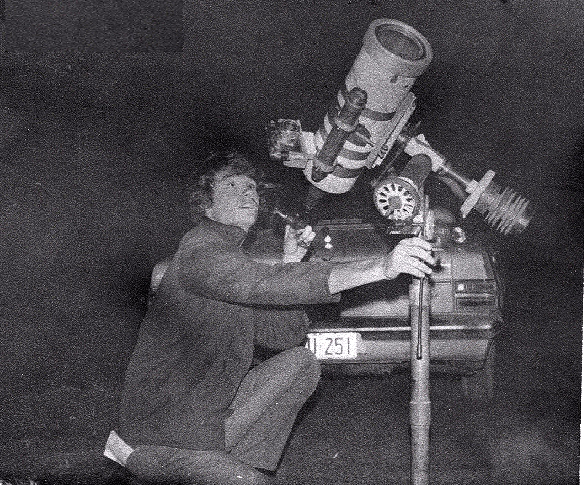
Using a wheel rim proved to be very stable, however sometimes on camping trips, there was insufficient room in the car for the rim. In those circumstances, I resorted to using the spare tyre. Even though this was not as stable as just the rim, it still proved very usable.
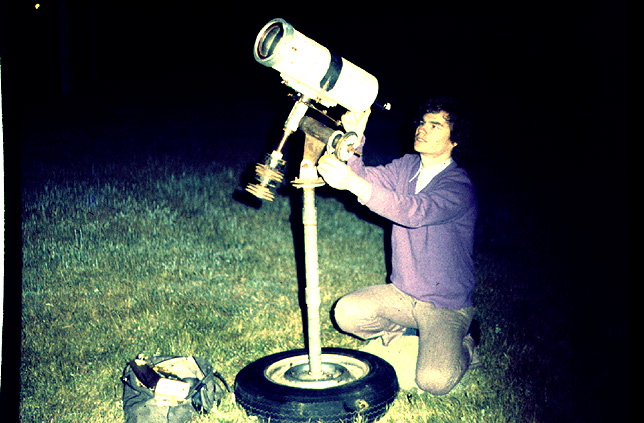
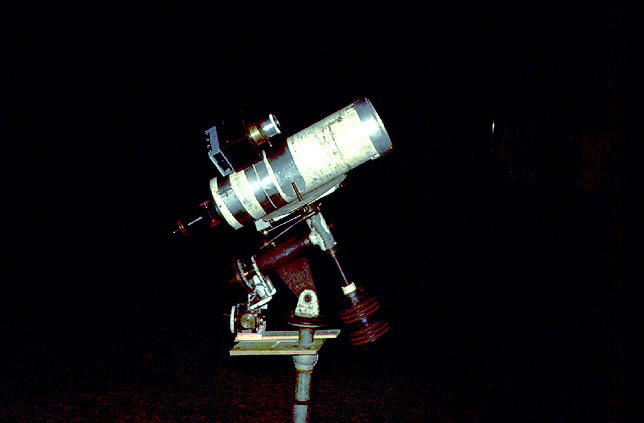
The 5" showing a later modification I made to the hand drive. I managed to finish this system just in time to photograph comet West in 1975. For a hand drive, the system worked very well. It was designed so that the wooden disk was turned at a rate of 3 revolutions per minute, which I had found to be a comfortable rate. Mounted on the side of the telescope is a 50mm f/2 astrocamera which I made from an old slide projector lens. Many of the wide-angle photographs of comet west were taken with this camera, which used 3.5" x 2.5" sheet film.
The 5" was originally made in about 1958 using a Jaegers cemented lens. Being only 25" focal length, it does suffer from some chromatic abberation and so any object brighter than 2nd magnitude shows a purple halo. However the images show excellent detail and it is breathtaking for wide field viewing. A 40mm extra-wide angle Pentax eyepiece gives 16x and a 4.5 degree field!

Three years later I purchased a 12" casegrain from the same person and eventually made a fork mounting for it. Unfortunately I was never able to devise a good motor drive for the telescope and with a focal ratio of f/32 a good motor drive was a must! As a result I sold the instrument after about 3 years. Before I sold it however, I moved the telescope from my backyard to a property belonging to a friend which was situated in a darker location. This worked quite well except during winter when much of the property was under water. Including where the telescope was set up!
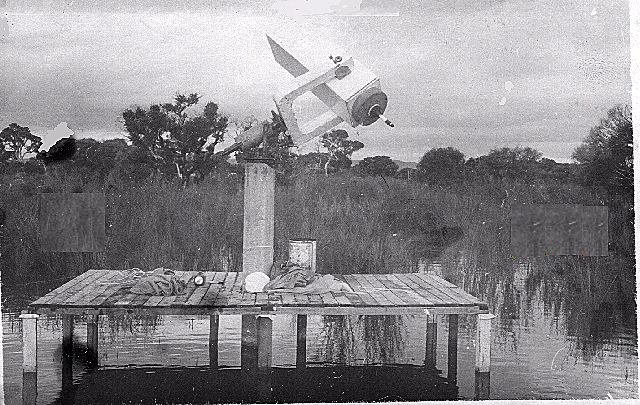
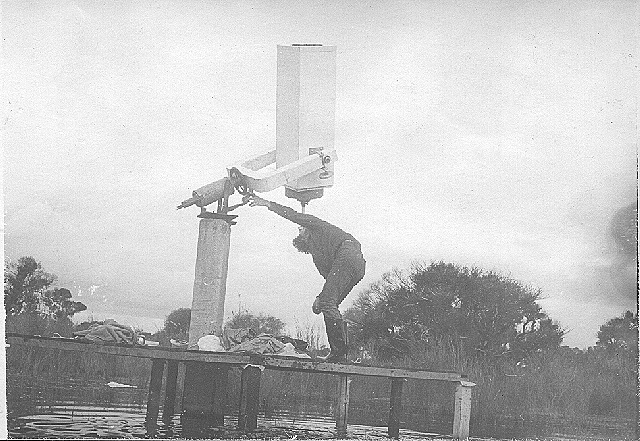
This meant that to use the telescope it was necessary to wade about 80 metres through knee-deep water! One thing that was interesting, was that the seeing conditions under these circumstances was exceptionally steady. Better than I have known anywhere else!
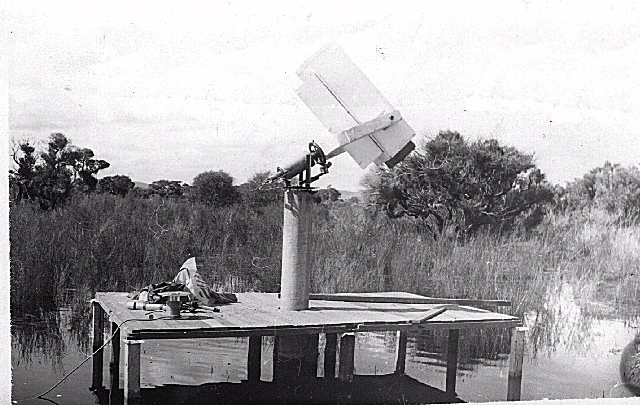
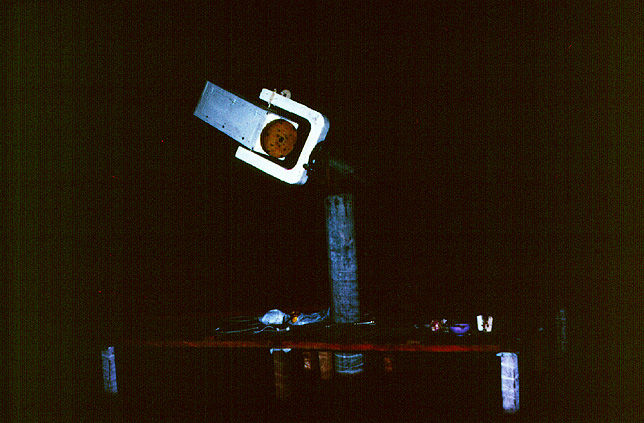
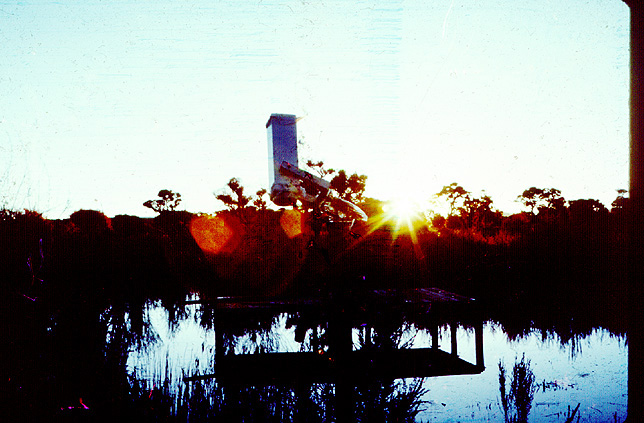
In 1979, I obtained a 10" f/9 newtonian telescope on loan from the astronomy club. This was an excellent instrument, especially for planetary observing. It was also very good as a guidescope for photographing with the 5" which I still owned.


I was able to use the 10" telescope for 6 years before I had to return it to the club. By this time we were starting to hear about the dobsonian system for mounting a large telescope cheaply. With this in mind I starting thinking about building a large telescope myself. However before I started paying money for large optics, I decided to build a smaller instrument first to try the system. Accordingly I purchased a 9" f/10 mirror and constructed a dobsonian telescope from it. The system worked better than I had hoped and so I ordered a 16" mirror and commenced building the rest of the telescope.

The 9" telescope is the large white instrument in this photograph. Alongside it is a 6" telescope I was repairing for the club and the tube and rocker box assembly for the 16".
When the mirror was ready for shipping I had to sell both the 9" and the 5" to finance the 16". I was disappointed to sell the 5" refractor as I liked that instrument. It was also disappointing to sell the 9", as that had the best optics I have even used. However the thought of the views through the 16" helped quell the disappointment! There was also the thought that, at the time, I owned the largest privately-owned telescope in Western Australia!
When the 16" was completed it did provide great deep-sky views, however it was very heavy, being nearly impossible to set up alone! After persisting with this situation for some months I eventually decided to toss the cardboard tube and massive rocker box, and replace them with a MUCH lighter box and truss tube system.

This setup made the telescope much easier to use and to transport, although it was difficult to collimate and this limited its use for planetary observing. For deep sky viewing however, it was excellent. My two most memorable occassions using this telescope were in 1985. The first was in April when, along with two friends, I managed to visually recover the periodic comet Honda-Mrkos-Padjusakova, The first time a returning periodic comet had been recovered by amateurs using visual means for over 30 years. (With none since!)
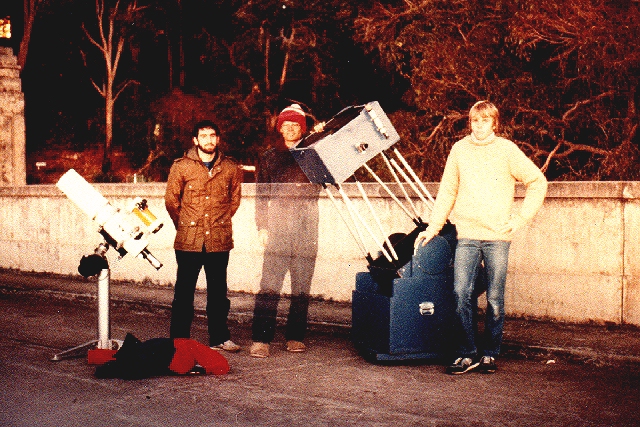
The second was in July when I became the first person in Australia to observe comet Halley visually. These two instances showed the advantages of a large telescope. Unfortunately not long after this I was forced to sell the 16".
Having been forced to sell the 16", I built a 10" newtonian using Coulter optics, and used it on an old Meade equatorial mount. I also purchased a 3" schmidt-newtonian to use as a guidescope.
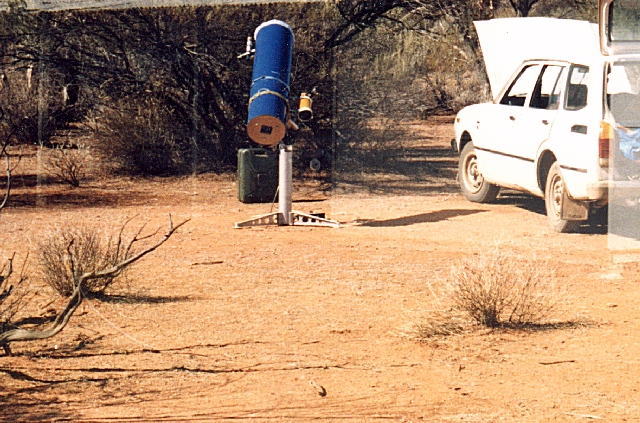
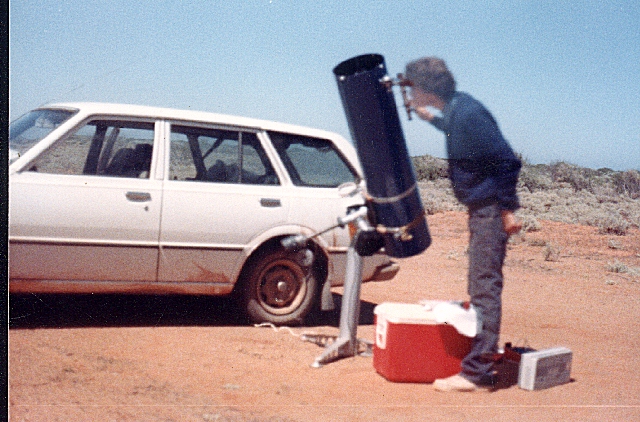
However the 10" was too large for the mount to handle with sufficient accuracy for photography. Still the system worked well for visual observing, so I built a dobsonian mount to make for easier use when visually observing.
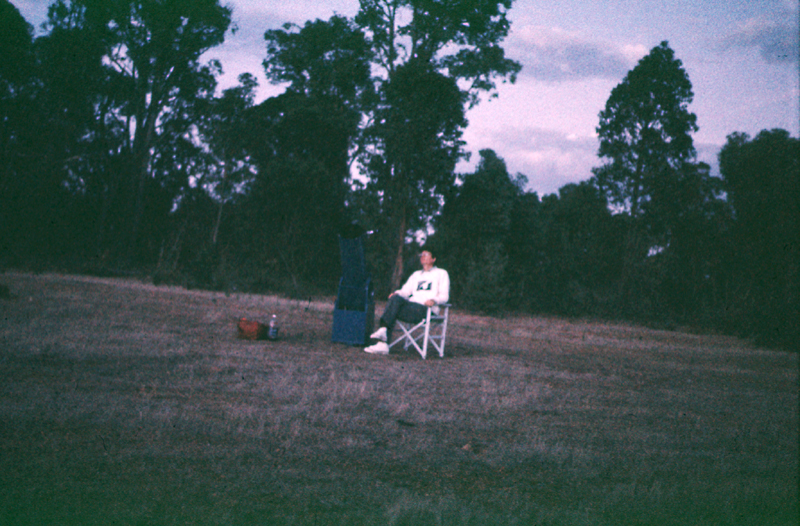
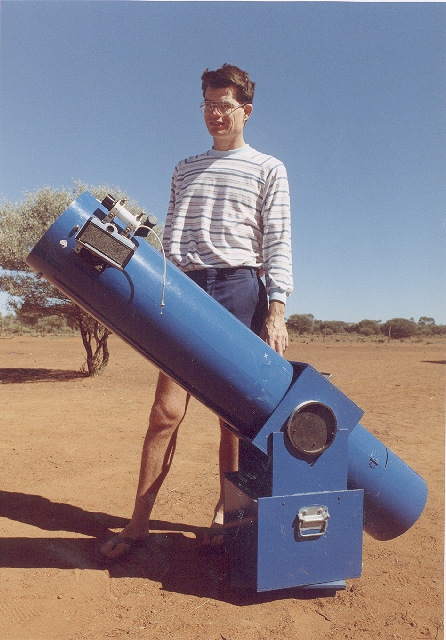
Not long after comet Halley I was forced to sell the 10" telescope as well, and so I built a 6" newtonian on a dobsonian mount. Fortunately by this time I was able to borrow a 12" dobsonian which had been left in Western Australia by Akira Fujii after his visit to observe comet Halley. I was also able to borrow a beautiful and highly portable equatorial mount by Mitaka, with a 6" f/3.75 schmidt-newtonian for photography, also courtesy of Akira Fujii.

In 1989 I learned that a friend of mine who now owned my old 5" refractor was wanting to sell it in order to build a larger instrument. So the 6" was sold and I again owned the 5". During the time that others had owned the 5", the focuser had been upgraded to a 2" model, and the old pipe mount had been replaced by a Meade equatorial. This mount was fine for visual observing but not accurate enough for photography. However, this proved not a problem as the 5" fitted easily onto the Mitaka mount, making the perfect astrophotography scope. I then built another 6" telescope for the Meade mount for visual observing while using the 5" for photography.
In 1998 I sold the 6" and used the money to purchase a Meade 416xt CCD. Since refractors are not particularly suited to CCD imaging, I built an 8" for using with the CCD. When the 5" was used for film imaging, the 8" went on a dobsonian mount for visual observing. At the same time I built a 4" refractor for use in viewing sessions for astronomy classes I was running. Another year later and I built yet another 6" dobsonian for these classes.
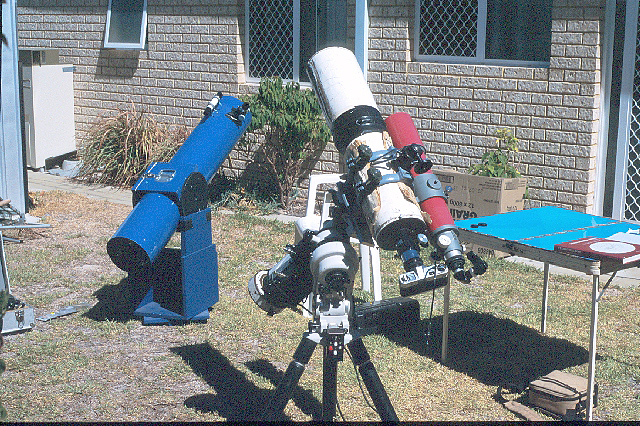
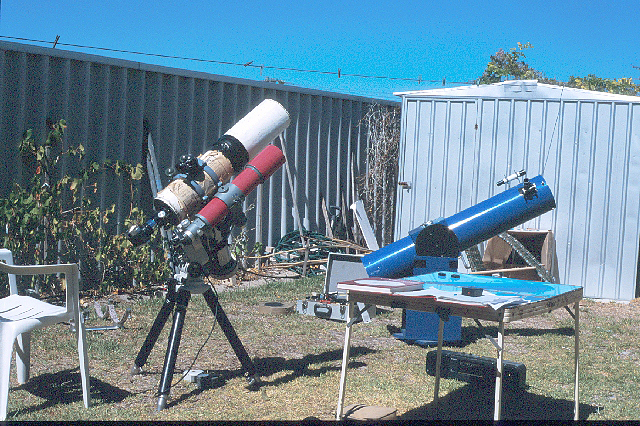
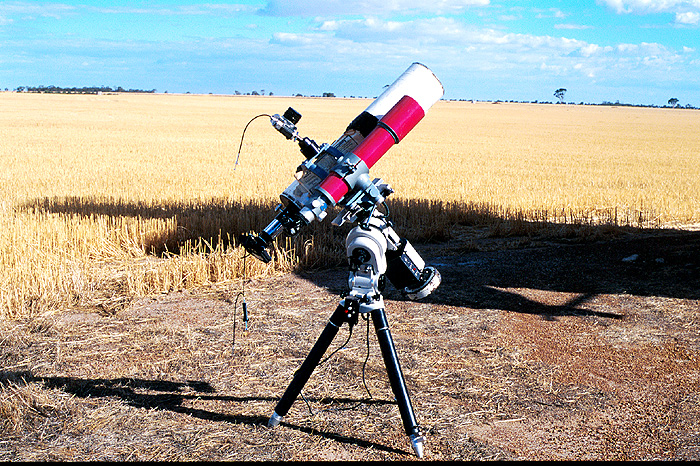
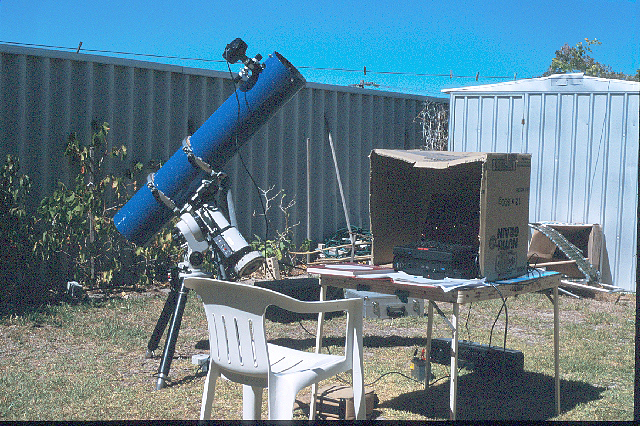
For CCD imaging, the 8" went onto the Mitaka mount. In the box on the table is a laptop for operating the CCD. The box was to keep any dew off the laptop. The laptop screen is covered with red celophane to preserve night vision.
In 2001 I was offered a lecturing position in the USA. Unfortunately I was unable to take all of my telescopes with me. Also the owner of the Mitaka mount decided it would be better if the mount remained in Australia as well. Reluctantly I returned the Mitaka to its owner and sold the newtonians and the 4" refractor to a friend who took over my astronomy classes. The 5" refractor migrated to the USA with me. When I arrived, I purchased a 10" f/6 Discovery dobsonian for visual use and a GM-8 mount and 3" guidescope for photography with the 5".

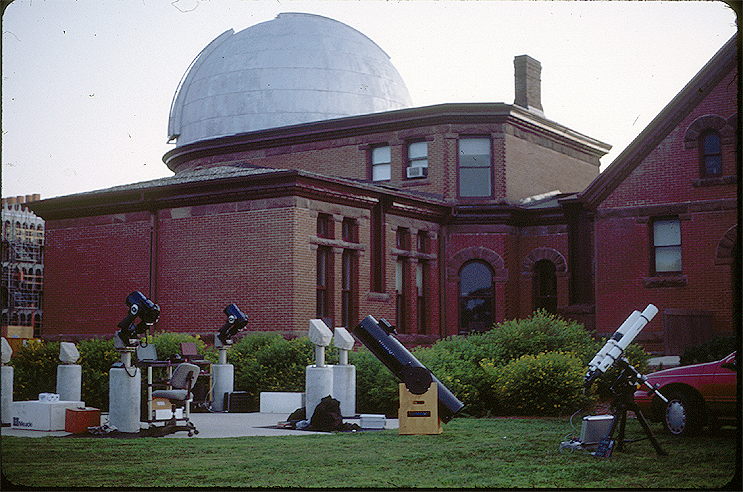
Setting up for a night of observing at the Goodsell Observatory in Minnesota. On the right is the 5" refractor ready for astrophotography. Next to it is the 10" Discovery. On the pedestals are 2 Meade 8" LX200's for CCD imaging. In the large dome is a 16" Brasheer refractor. Just out of view at the left is another dome that houses an 8" Clark refractor.
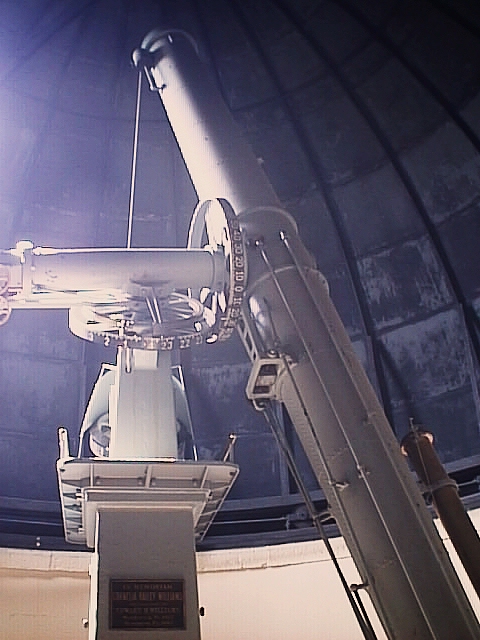
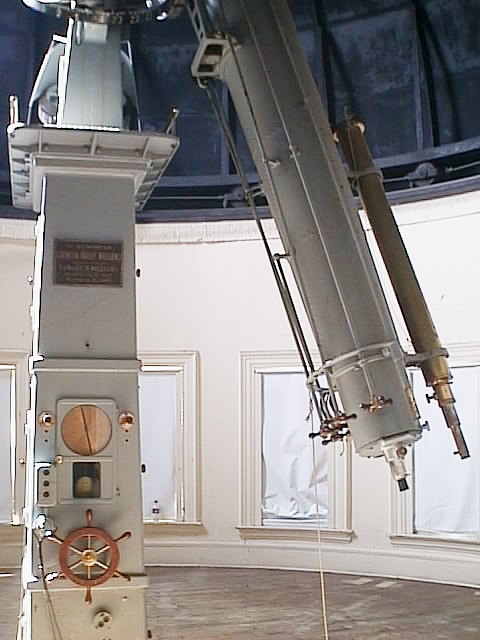
The 16" Brasheer refractor at the Goodsell Observatory. Over 100 years old, the telescope still has its original weight drive, yet it is balanced so well that it was possible to take 3 minute CCD images without any trailing.
After 2 years, I decided that, with the large refractors in the university observatories being great for visual observing, the 10" was not getting much use, so I sold it and put the money towards a Celestron 14 and a Losmandy Titan mount with Gemini GoTo for CCD imaging. I also sold the Meade 416 and purchased an SBIG ST-9E. Finally, I added an ST-4 autoguider to the 5" to save the necessity of manual guiding.

Ever since I was forced to sell the 16", I have dreamed of owning my own large dobsonian for visual observing. After watching the second-hard market for several years waiting for such an instrument, I finally took the plunge and purchased an 18" starmaster.

The 18" telescope being used while on a visit to the Rosemary Hill observatory.

Later I added a set of narrow-band filters for the ST-9 and purchased a camera lens adapter so I can do wide-field CCD imaging. I also purchased an SBIG STL 1001E, also with a set of narow-band filters and a Canon Rebel DSLR modified for astrophotography.
The next change to the equipment was to upgrade the C14 mount from the Titan to a Paramount. This meant that I now I had a large telescope with wide-format CCD for CCD imaging, the 5" refractor for either DSLR or CCD imaging, a setup for wide-field CCD imaging, and a large telescope for visual observing! Astronomy heaven!!!! Just what I always wanted. And With all that equipment to play with, the nights were never booring!!!!!
Then I moved to a new position in Texas where the university has a wonderful 20" PlaneWave telescope. This instrument is excellent for CCD imaging, and will reach 20th magnitude in just 3 minutes!

The 20 inch Plane Wave telescope with the STL-1001E attached.
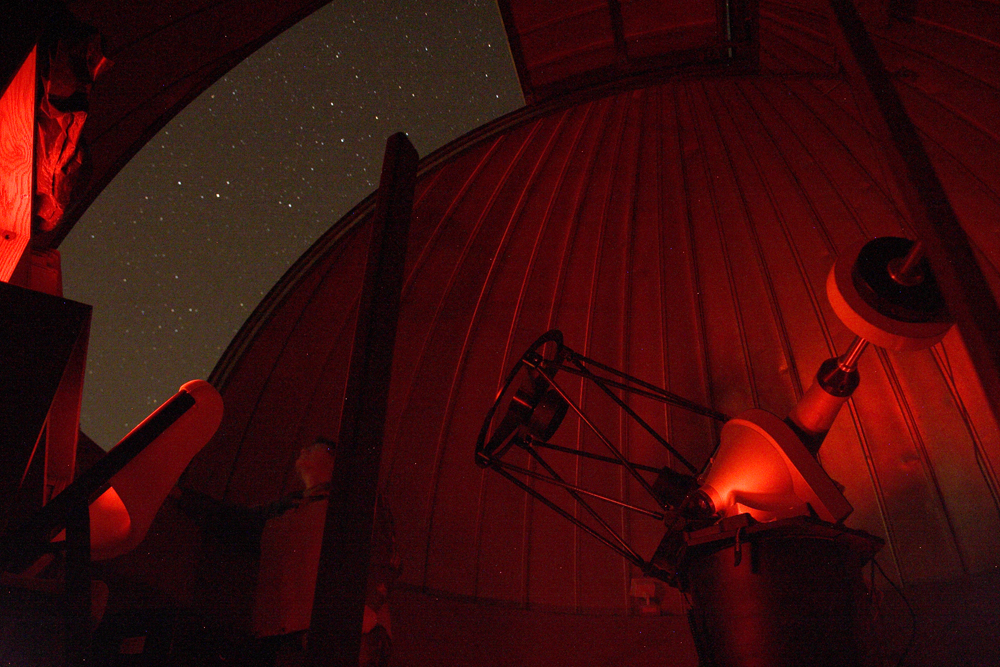
Stars of Serpens Caput shine through the slit of the 20 inch telescope dome.
What this meant was that I now could observe and image with 4 telescopes at once!!!!
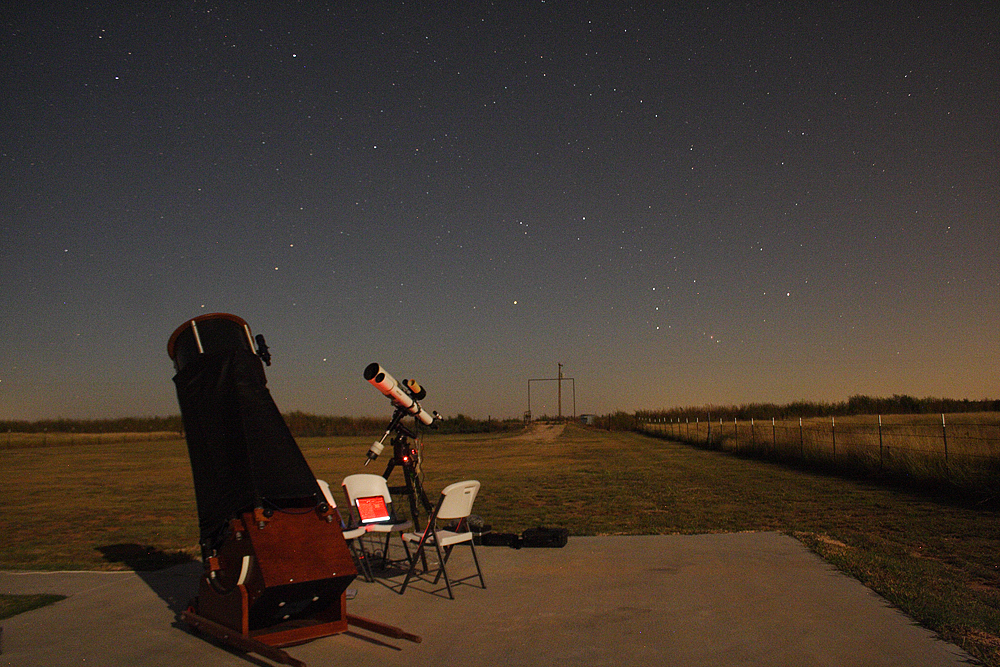
Orion rises behind the 5" and 18" telescopes being used outside the university observatory. Moonlight has been used to illuminate the telescopes.
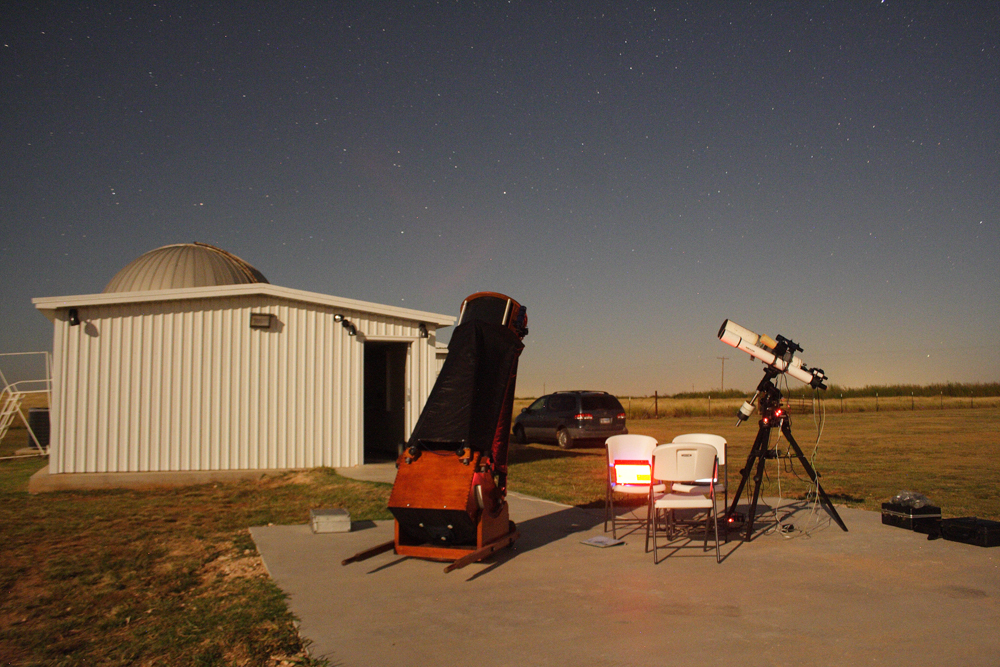
The stars of Ursa Major and Lynx rise behind the the university observatory. Moonlight has been used to illuminate the telescopes.
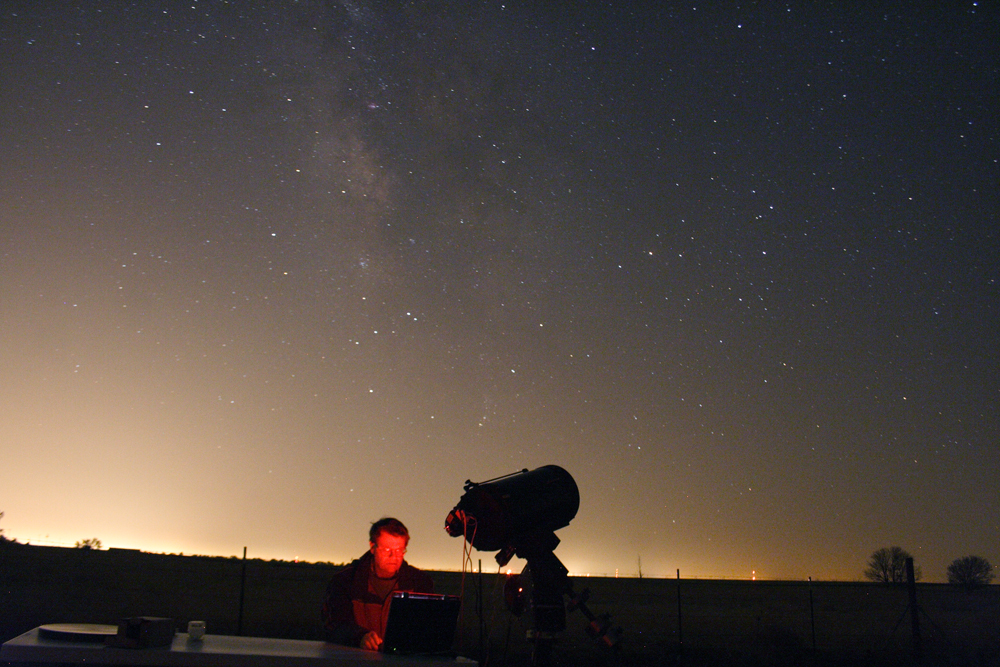
The stars of Scorpius setting over the C14. Looking south towards the town.
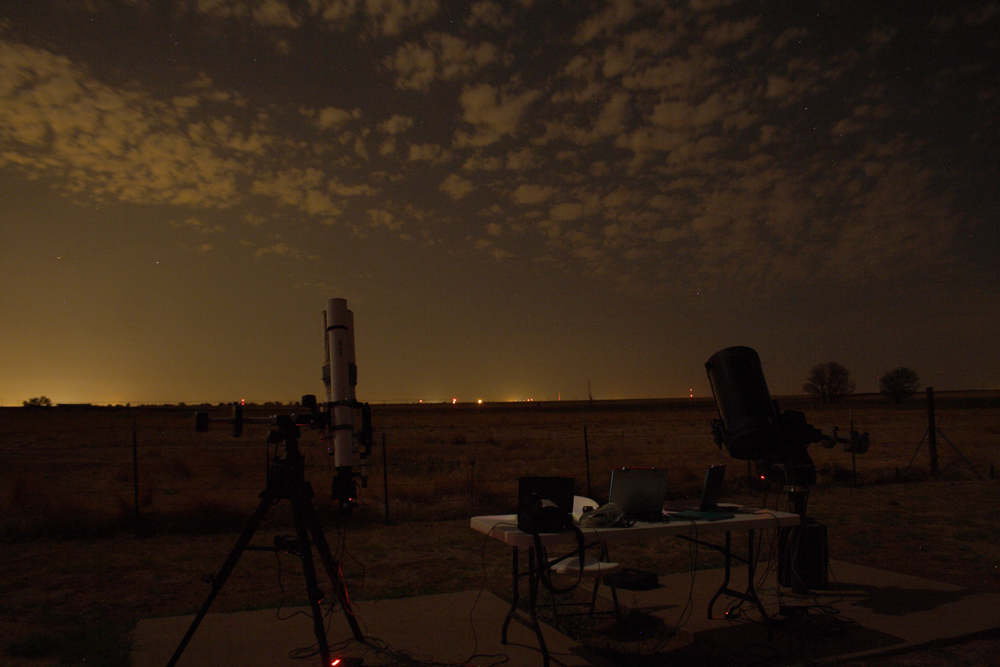
The 5" and C14, still waiting for the couds to clear. :-(.
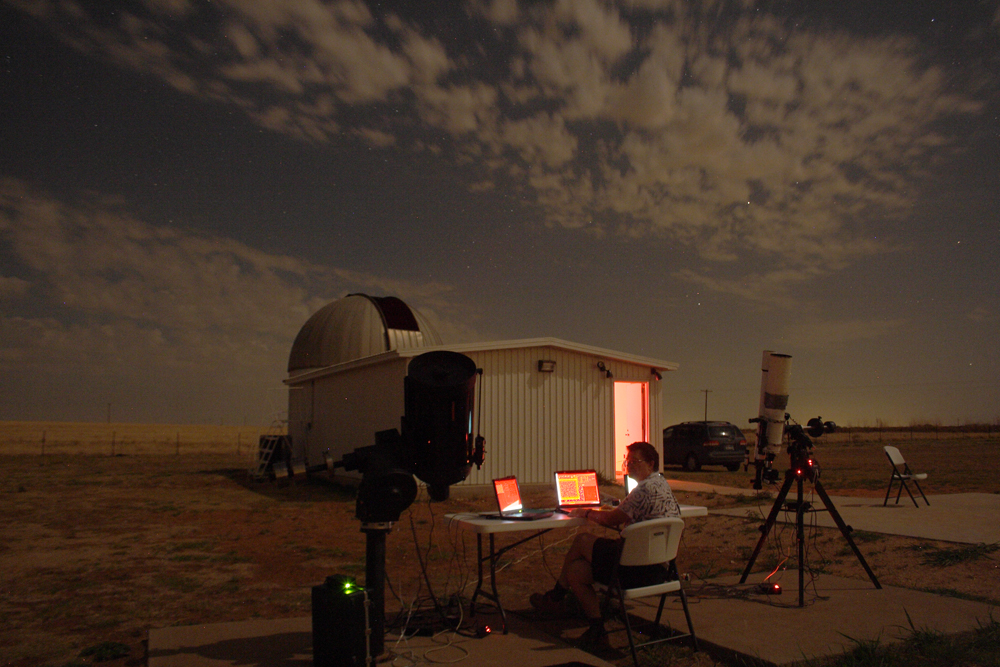
The 5" and C14, looking north over the 20" dome.
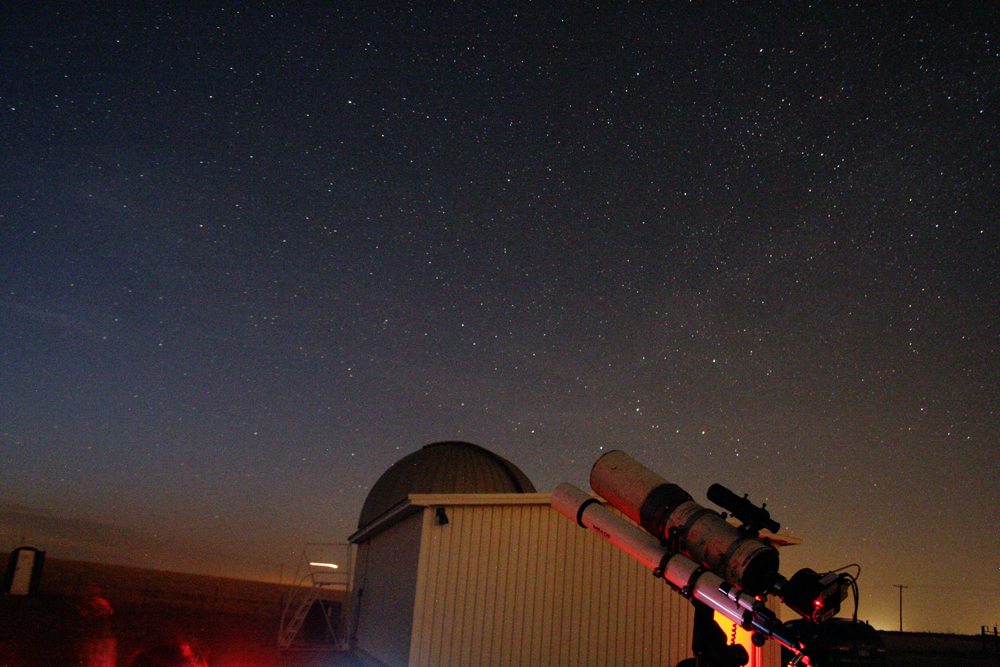
Cassopeia rises ove the 5" and the 20" dome. The bright streak to the left of the dome was a plane coming in to land at the local airport.
After using the 20" for a while, the comparissons with the C14 were painful. How could I go back to only using the C14 when I retired??? So, much to the dismay of THE BOSS I went ahead a purchased my own 20" PlaneWave on a Software Bisque Paramount ME mount. I still have the C14, but that will eventually have to be sold, probably along with the 18". :-( However I will keep the 5" for wide-field viewing and imaging.
My main worry now, is how to transport all this equipment back to Australia when I am ready to retire!!!!!!! Already on the lookout for a property in the bush with mag 8 skies!!! :-)